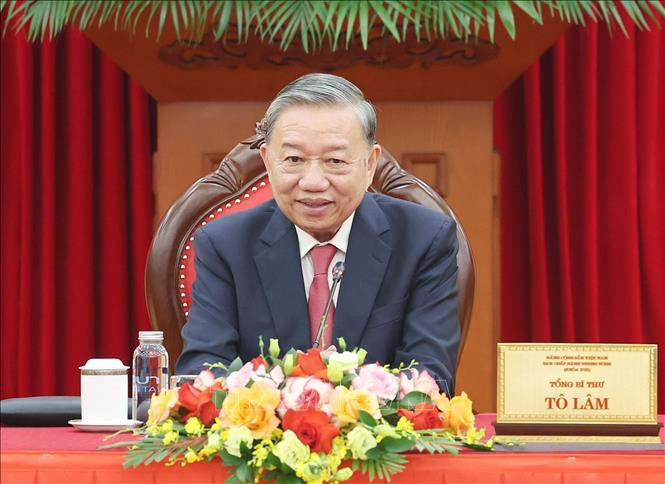During a phone call on the evening of July 2, General Secretary To Lam and US President Donald Trump welcomed the consensus reached by their negotiating teams on a Joint Declaration for a reciprocal, fair, and balanced trade framework between Vietnam and the United States.
President Trump praised Vietnam’s commitment to offering preferential market access to American goods, including large-displacement automobiles. He confirmed the US would significantly reduce retaliatory tariffs on many Vietnamese exports and continue working with Vietnam to resolve trade-related issues, especially in priority sectors for both countries.
General Secretary To Lam urged the US to recognize Vietnam as a market economy and lift export restrictions on several high-tech items.
The two leaders also discussed key strategies to deepen the Comprehensive Strategic Partnership in the coming years. They agreed to increase high-level exchanges and promote cooperation in economics, trade, and investment - particularly in critical and breakthrough fields such as science and high technology.

Trump announces 20% tariff on Vietnamese exports
In a social media post following the call, President Trump announced a 20% tariff on Vietnamese exports to the US, and a 40% tariff on goods deemed to be “transshipped,” while American products entering Vietnam would enjoy a 0% tariff rate.
With nearly 30% of its exports bound for the US, Vietnam is heavily reliant on the American market. The new tariffs could have profound implications for the country’s economy.
20% tariff on Vietnam-origin goods
Key Vietnamese export sectors - especially textiles, footwear, and electronics - must closely monitor developments, given their strong dependency on the US market.
Trump described the 20% tariff as “fair and necessary to protect American workers.” While this is significantly lower than the previously floated 46% rate, it remains a notable figure by regional standards.
The US’s retaliatory trade policy under Trump is shaping a complex and varied tariff landscape across ASEAN.
40% tariff on transshipped goods
This is arguably the most striking feature of the deal. Goods suspected of being “transshipped” - where foreign products are merely repackaged or relabeled in Vietnam before being exported to the US - will be subject to a record 40% tariff.
US Commerce Secretary Lutnick had previously warned about such transshipment activities in Senate testimony.
However, there remains considerable ambiguity about the specific criteria for identifying “transshipped” goods. Will 20%, 30%, or 50% foreign component content constitute a violation?
Until clear guidelines are issued, Vietnamese companies will face significant legal risks and compliance costs.
0% tariff for US goods entering Vietnam
President Trump also announced plans to negotiate zero tariffs for US exports to Vietnam, especially highlighting electric and gasoline vehicles. If enacted, this would offer a major competitive edge to American firms like Tesla and Ford, placing domestic manufacturers - particularly VinFast - at a disadvantage.
Automobiles – EVs – Auto parts: This sector could be hardest hit. US-made electric vehicles (Tesla, Rivian) and gasoline cars (Ford, Chevrolet) entering Vietnam tariff-free will intensify competition.
Technology – Consumer electronics: The US leads in high-end electronics such as chips, servers, and professional computers (Apple, HP, Dell). Vietnamese OEMs and Chinese electronics assemblers may struggle as genuine US products enter more cheaply.
High-tech agriculture & food processing: The US, as an agricultural powerhouse, could flood Vietnam with products like beef, frozen chicken, corn, soybeans, dairy, and processed foods. Domestic firms like TH, Vinamilk, Masan, and Ba Huan will face direct competition.
Retail & e-commerce: Giants like Amazon and Walmart, as well as US consumer brands, may penetrate Vietnam’s distribution network more deeply without tariff barriers. Local retailers like Co.opmart and Bach Hoa Xanh, and e-commerce platforms like Tiki and Sendo, will face fierce rivalry as US goods reach consumers directly.
In summary, a 0% tariff on US products means Vietnam is opening its market in a way that benefits consumers but poses stiff challenges for local manufacturers.
Unresolved issues remain
Several aspects of the agreement still require clarification:
Will the 20% tariff apply universally to all non-transshipped goods, or will there be exemptions?
What criteria will determine transshipped goods, and what component thresholds constitute a violation?
Besides retaliatory tariffs, does the agreement include a framework for other taxes such as VAT or address market access barriers?
Despite uncertainties, the US stock market and some Vietnam-linked listed partners responded positively. Nike’s shares, for example, rose yesterday - suggesting investor optimism about the deal.
Compared to other countries in the region, the 20% tariff is not excessive. In some respects, it could compel Vietnamese businesses and the broader economy to elevate their production capabilities and climb higher up the value chain, rather than remaining in labor-intensive, low-value assembly roles.
Tu Giang